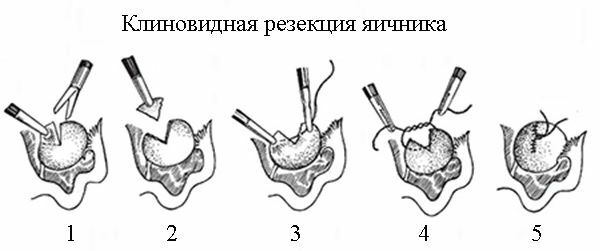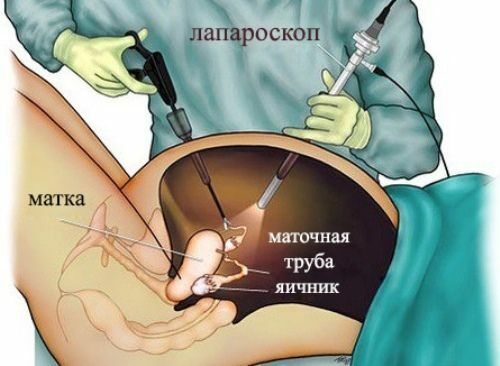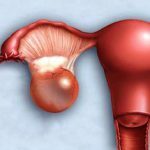The cyst is a benign neoplasm, which is a cavity and can be formed in any organ. Most often, functional cysts are formed, which in time simply disappear - a person does not even know about the existence of a new growth. If it is formed in an organ permeated with blood vessels, a hemorrhage may occur in the cavity. In this case, a hemorrhagic cyst will be diagnosed. In gynecology, such formations are formed on the ovaries.
Causes of hemorrhagic ovarian cyst
appearance of tumors, doctors are always associated with pathological changes in the hormonal system of the woman. To develop such violations, there are provoking factors, which include:
- pregnancy;
- induced abortion;
- frequent stress and other disorders of psycho-emotional background;
- long-term use of certain drugs from the hormone category;
- changes related to age.

There are cases when the hemorrhagic cyst was formed in a woman with diagnosed and untreated diseases of infectious etiology( venereal) and inflammations.
And here is more about inflammation of the ovarian cyst.
Symptoms of hemorrhagic cyst of the ovary yellow body
Neoplasm begins its formation in the first phase of the menstrual cycle and at the beginning of this process is functional. At such an early stage of progression, the woman does not notice anything, her health does not deteriorate. But when the rupture of blood vessels occurred, their contents fell into the cavity of the already formed cyst, the following symptoms may be of concern:
- pain syndrome in the lower abdomen: it is pulling / stupid, stable and successfully removed with drugs with analgesic effect;
- menstruation becomes painful, and if there was one before the formation of hemorrhagic cyst, the discomfort will be more pronounced;
- during menstruation, the amount of secretion is significantly increased;
- cycle becomes irregular;
- in the perineum and the bottom of the abdomen is always present feeling of heaviness;
- nausea and vomiting( extremely rare).
Pain and pulling sensation women are often associated with excessive physical exertion, the above symptoms can occur only at certain times, for example, after intercourse or with urination.

How dangerous is the cyst with hemorrhagic contents
The cavity of the cyst is constantly filled with hemorrhagic fluid, with loads, the capsule breaks and the contents leak into the abdominal cavity or penetrate into the ovarian tissue. This will result in peritonitis or ovarian rupture( apoplexy).The state of rupture of the capsule is always accompanied by characteristic symptoms:
- acute abdominal pain;
- sudden weakness;
- marked pallor of the skin, lips can acquire a bluish tinge;
- pressure reduction( often acute);
- loss of consciousness( not always).

And one more nuance: the presence of hemorrhagic cyst can provoke miscarriage during pregnancy in the early stages.
Diagnosis of cysts with hemorrhagic contents
A gynecologist can diagnose on the basis of a patient's complaints and her examination, since the symptoms of a haemorrhagic cyst are characteristic. Feeling through the abdominal wall of the ovaries and fallopian( uterine) tubes will be an additional confirmation of the diagnosis( in the normal state this can not be done).
To clarify the nuances the doctor will send the patient for additional examination. As part of the diagnosis of hemorrhagic cyst used:
- ultrasound of the pelvic organs;
- Magnetic Resonance Imaging;
- laparoscopy.
The latter type of survey allows not only to accurately determine its size and location, but also to find out the nature of the content. A doctor can still undergo an operation during such a diagnosis.
Look at the video about the ovarian cyst:
When to seek immediate medical attention
Drawing pains and unusually heavy discharge during menstruation can bother a woman for several months. As a rule, in this case, uncomfortable sensations are removed with usual anesthetics, and the doctor is ignored. Meanwhile, there are a number of signs that relate to "signals" about the need for an urgent trip to the gynecologist:
- the pain in the lower abdomen has become more intense and has a clear localization from the side where the problematic ovary is located;
- menstrual cycle is broken permanently, and it is impossible to compile its calendar for 2 - 3 months in a row;
- occasionally present nausea and the urge to vomit, which are not related to eating.
If the woman fainted, became pale, the pulse is characterized as threadlike, then you should immediately call the ambulance brigade.
Treatment options for hemorrhagic ovarian cyst
Treatment of the disease in question will in any case be only surgical. Very rarely a gynecologist prescribes hormone therapy( this is possible when diagnosing a hemorrhagic cyst at the earliest stage of its formation).As mentioned above, this happens by chance, within the framework of general medical examination or treatment to doctors on another occasion.
During the examination of the patient, the gynecologist has the opportunity to determine the type of surgical intervention.
Culling out
cyst If a small tumor was detected during a woman's examination and the absence of a risk of developing cancer is confirmed, then the doctors will perform an operation to remove the cysts only - excision. This method of treatment specialists try to apply in each case, as it allows to preserve the functionality of the ovary.
After surgery, a woman will have to undergo a course of therapy with hormonal, antibacterial drugs and vitamin-mineral complexes.
V-groove resection
If the hemorrhagic cyst was formed and developed long enough, the doctors will find pathologically altered ovarian tissue during the examination. This is due to the squeezing of a growing education. In this case, a wedge resection will be performed, when the cyst is removed along with a fragment of the injured organ tissue. Cutting the desired area is done in the form of a triangle - hence the name of the operation.
After such treatment, the functionality of the ovary is preserved, a woman can later become pregnant, endure and give birth to a healthy child.

Surgical removal of the ovary with a cyst
Such an intervention is extremely rare, which is associated with the medical examination of the population and raising the level of women's awareness - they regularly undergo examinations with gynecologists. Often complete removal is done for patients older than 45 years( the reproductive function is already extinct) and when diagnosing several of the entities under consideration, given the existing threat of rupture.
If a woman has a ruptured hemorrhagic ovarian cyst, then most likely she will undergo an operation of this type. The decision is made by a gynecologist.
If a woman has only one ovary removed, she will be able to become pregnant. When surgical removal of the ovary with a cyst of a woman in the menopause period, doctors excise and fallopian( uterine) tube.
Complications after removal of hemorrhagic ovarian cyst
If complete removal of the cyst with the ovary, then during the rehabilitation period, it is possible to develop both an inflammatory and an infectious process. And here vyluschivanie and klinovidnuju a resection spend a modern method - a laparoscopy. Its essence lies in the penetration of instruments into the neoplasm through punctures in the abdominal wall.
Complications after such a surgical intervention practically do not happen. It can be noted that laparoscopy reduces the recovery period, eliminates bleeding and infection.

Can I get pregnant after removing the cyst and when
If the functionality of the ovary is not broken, then pregnancy can occur just a month after the treatment. But doctors insist on abstaining from sexual intercourse for a month and a half or two months and at least for a half a year on protection from pregnancy. This is due to the need to fully restore health.

Prevention of the appearance of hemorrhagic cyst of the yellow body of the ovary
It is possible to prevent the formation of a tumor of this type, but for this it is necessary:
- to visit the gynecologist on a regular basis and undergo a survey;
- timely and fully treat inflammatory diseases of internal genital organs;
- to avoid accidental sexual relations and use contraceptives - this will prevent infection with sexual infections;
- , when the first signs of a health problem appear, consult a doctor.
And here is more about the treatment of parovarial ovarian cyst.
The hemorrhagic cyst of the ovary is quite dangerous for the health and reproductive function of a woman. If the tumor breaks and the flow of its contents into the abdominal cavity, peritonitis can develop, a pathology that carries a risk to the life of the patient. But since the symptoms of hemorrhagic cysts are characteristic, the development of the disease depends only on the woman herself. To avoid problems, she must turn in time to the gynecologist and undergo the prescribed treatment.

 We recommend reading the article on the monthly for an ovarian cyst. From it you will learn about the disease and its effect on menstruation, the consequences of rupture of the cyst, as well as ways of normalizing the cycle.
We recommend reading the article on the monthly for an ovarian cyst. From it you will learn about the disease and its effect on menstruation, the consequences of rupture of the cyst, as well as ways of normalizing the cycle.  We recommend reading the article on the delay of menstruation with an ovarian cyst. From it you will learn about the signs and symptoms of the disease, the causes of its development, the relationship between cysts and menstruation.
We recommend reading the article on the delay of menstruation with an ovarian cyst. From it you will learn about the signs and symptoms of the disease, the causes of its development, the relationship between cysts and menstruation.